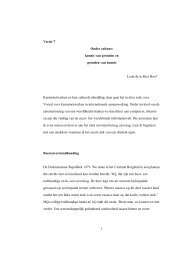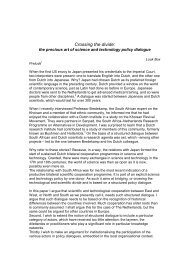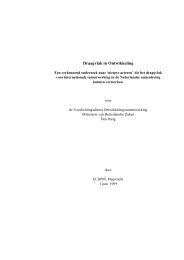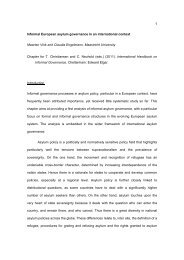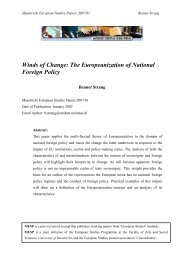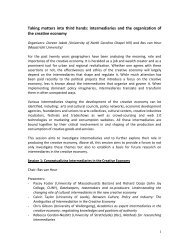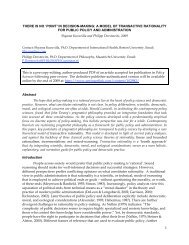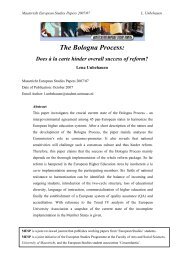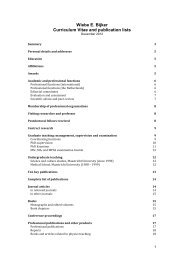the case of the synthetic dye industry, 1857–1914 - Maastricht ...
the case of the synthetic dye industry, 1857–1914 - Maastricht ...
the case of the synthetic dye industry, 1857–1914 - Maastricht ...
Create successful ePaper yourself
Turn your PDF publications into a flip-book with our unique Google optimized e-Paper software.
202 J.P. Murmann and E. Homburg<br />
<strong>the</strong> global leaders. By producing a large number <strong>of</strong> chemical intermediates, <strong>the</strong>se<br />
firms were able to <strong>of</strong>fer a full portfolio <strong>of</strong> <strong>dye</strong>s that smaller firms could not<br />
deliver to <strong>the</strong>ir customers. Because <strong>the</strong>y give larger firms a lower cost structure,<br />
economies <strong>of</strong> scale and scope can act as general forces that, over time, eliminate<br />
smaller competitors from <strong>the</strong> market.<br />
Technological dynamics<br />
Technological dynamics can have a direct impact on industrial dynamics. The<br />
invention <strong>of</strong> syn<strong>the</strong>tic <strong>dye</strong>s destroyed <strong>the</strong> business <strong>of</strong> natural <strong>dye</strong> growers. When<br />
substitute products are created, existing producers who are not able to switch to<br />
a new technology are likely to be eliminated. 31 Technology can also change <strong>the</strong><br />
minimum efficient scope and scale (<strong>the</strong> plant size at which production cost per<br />
unit is lower than at any o<strong>the</strong>r size). In <strong>the</strong> <strong>dye</strong> industriy, for example, production<br />
equipment was scaled up dramatically from 1857 to 1914. In many industries<br />
technological innovation increases <strong>the</strong> minimum efficient scale. But technological<br />
innovations can also have <strong>the</strong> opposite effect <strong>of</strong> decreasing <strong>the</strong> minimum efficient<br />
scale. An example is <strong>the</strong> invention <strong>of</strong> minimills in <strong>the</strong> steel <strong>industry</strong>. As a general<br />
hypo<strong>the</strong>sis, we propose that increases in <strong>the</strong> minimum efficient scope or scale<br />
reduce <strong>the</strong> number <strong>of</strong> firms, and decreases in <strong>the</strong> minimum efficient scope or<br />
scale increase <strong>the</strong> number <strong>of</strong> firms.<br />
Positive feedback<br />
Much <strong>of</strong> economic <strong>the</strong>ory is based on <strong>the</strong> logic <strong>of</strong> negative feedback. If prices<br />
for a commodity increase substantially, new producers will enter <strong>the</strong> market and<br />
<strong>the</strong> additional quantities <strong>of</strong> goods on <strong>the</strong> market will bring prices down again. In<br />
a world <strong>of</strong> negative feedback, <strong>the</strong> development <strong>of</strong> advantages in market share,<br />
industrial infrastructure, or in legal environment will not make a difference over<br />
time. The incentives for o<strong>the</strong>r players to catch up will be large and with time<br />
lead to a competitive equalization <strong>of</strong> positions. In a world <strong>of</strong> positive feedback,<br />
however, small differences in conditions can translate into large differences in<br />
outcomes over time (Arthur, 1994). The monopoly <strong>of</strong> La Fuchsine that led to a<br />
shakeout in France appears to have given German firms a small advantage that<br />
<strong>the</strong>y were able to translate into a complete domination <strong>of</strong> <strong>the</strong> French <strong>dye</strong> <strong>industry</strong><br />
before <strong>the</strong> First World War. The central feedback mechanisms in this setting were<br />
pr<strong>of</strong>it levels and investments in new firm capabilities, and later lobbying efforts.<br />
Initially small differences in market share were translated into large differences<br />
in market share because successful firms could invest more than less successful<br />
rivals. A firm that made less money possessed fewer resources to invest in <strong>the</strong><br />
31 Among <strong>the</strong> firms that switched from natural <strong>dye</strong>s to syn<strong>the</strong>tic <strong>dye</strong>s early on were Jäger, Knosp,<br />
and Geigy and later Thomas Frères (madder producers). When syn<strong>the</strong>tic alizarin killed <strong>the</strong> madder<br />
business, <strong>the</strong> largest Dutch madder producer, Salomonson, successfully switched to making phosphate<br />
fertilizers.



